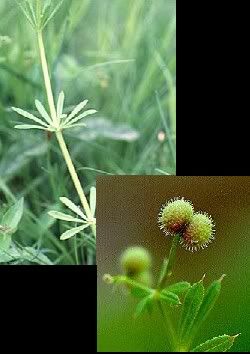

Fragrant Bedstraw (Galium aparine, G. verum)
Folk Names: Barweed, Bedstraw, Catchweed, Cleavers, Cleaverwort, Click, Clite, Clitheren, Clithers, Clivers, Coachweed, Curdwort, Eriffe, Everlasting Friendship, Goose Grass, Goosebill, Gosling Weed, Grip Grassman, Hayriffe, Hedge-burs, Hedgeheriff (Anglo-Saxon “tax gatherer”), Loveman, Madder's Cousin, Mutton Chops, Philanthropon (Greek), Poor Robin, Robin-run-in-the-grass, Scratweed, Stick-a-back, Sweethearts; G. verum - Catchstraw, Cheese Rennet, Cheese Renning, Lady's Bedstraw, Maid's Hair, Our Lady's Bedstraw, Petty Mugget, Yellow Bedstraw, Yellow Cleavers
Description: Bedstraw is a member of the madder family and related to coffee. Galium aparine is an annual, preferring moist, grassy, loamy woods, hedges, and thickets. It may be found in Canada, the eastern US, the Pacific Coast and in Eurasia. The slender tap root rises to a weak quadrangular, procumbent or climbing, stem two to six feet long with scratchy, recurved bristles. The rough leaves are small and narrow, oblong-lanceolate to almost linear, growing in whorls of six to eight around the stem. The small white or greenish-white flowers have four petals and appear in cymes on long axillary peduncles from May to September in the axils of uppermost leaves. These produce one seed in the form of two joined bristly globular capsules about 1/8 in across.
Galium verum prefers dry fields, sunny slopes, and open woods, especially near the sea. It grows from Newfoundland to Ontario, south to Virginia, west to Ohio, Missouri, Kansas and North Dakota. It origins lie in Europe however. The smooth, slender stem is square and grows six inches to three feet in length. The rough leaves are narrow and linear with bristly tips. They can be as long as one inch with soft hairs on the underside. The leaves appear in whorls of four to eight around the stem nodes. From June to August, tiny four-petaled, yellow flowers grow in dense panicles. While the plant has no discernable odor, it does have a bitter, astringent taste.
Effects: gentle
Planet: Venus
Element: Water
Associated Deities:
Traditions:
According to legend, fragrant bedstraw (G verum) was placed in the manger by the Virgin Mary. This is where it gets many of its names.
Magic:
Bedstraw may be worn or carried for love. Geese are said to have a fondness for the plant, so if you happen to want them around, bedstraw might come in handy. Of course, geese like just about any kind of food you might offer them and will hang around for that as much as anything else.
The dried and powdered root is said to stop bleeding wounds and promote healing, and the juice mixed with oatmeal to the consistency of oatmeal may be applied to “tumors” for three days. Gerard said that the herbs as a remedy for snake and spider bites, probably due to its astringent properties. Culpepper suggested the juice for earache.
Known Combinations:
none noted
Medical Indications: Parts Used: herb
Bedstraw is anti-scorbutic, and shoots are high in C making them good for spring tonic and scurvy. The entire plant may be used as a tea for kidney stones and bladder problems, especially with herbs such as broom, uva ursi, buchu and marshmallow. As a wash or lotion, it is said to fade freckles and sunburn; it is also good for psoriasis. Galium verum is a styptic. It is good for footbaths, as a diuretic tea, and supposedly as a treatment for epilepsy.
Nutrition:
The seeds of fragrant bedstraw may be roasted and ground as a caffeine-free, coffee substitute. The young shoots of Galium aparine are boiled for ten to fifteen minutes and served with butter or chilled and added to salad. In Greece, a strong decoction of Galium verum leaves and stems was used as curdling agent in cheese making.
Mercantile Uses:
The roots of Galium aparine contain a yellow-red dye, though the roots of all madder plants grow so sparsely as to be scarcely worth growing or harvesting for this purpose. Galium verum was used as a traditional mattress stuffing. Like G aparaine, the roots of g verum also produce a permanent red dye, and yellow dye comes from the flowers, leaves, and stems. During the reign of King Henry VII (1485-1509), the flowers were used as a hair dye, and British dairymen used it to color cheese.
It is a favorite food of geese, though horse, cows, and sheep will eat it as well.